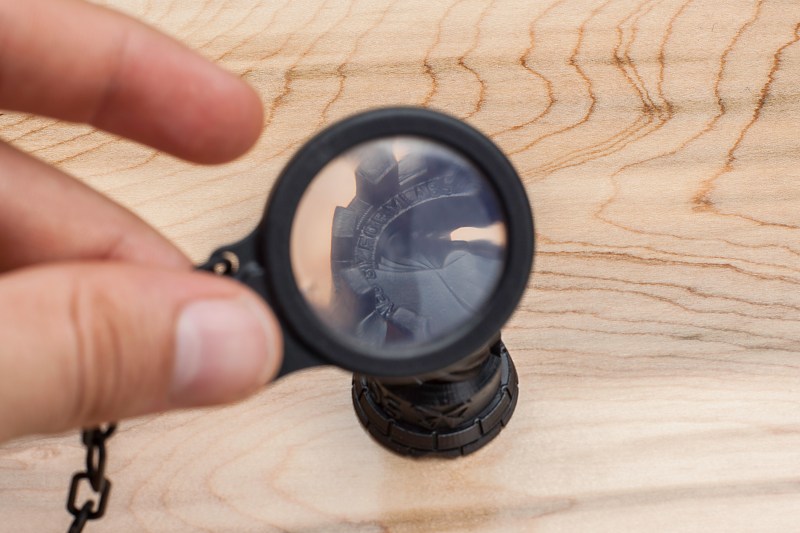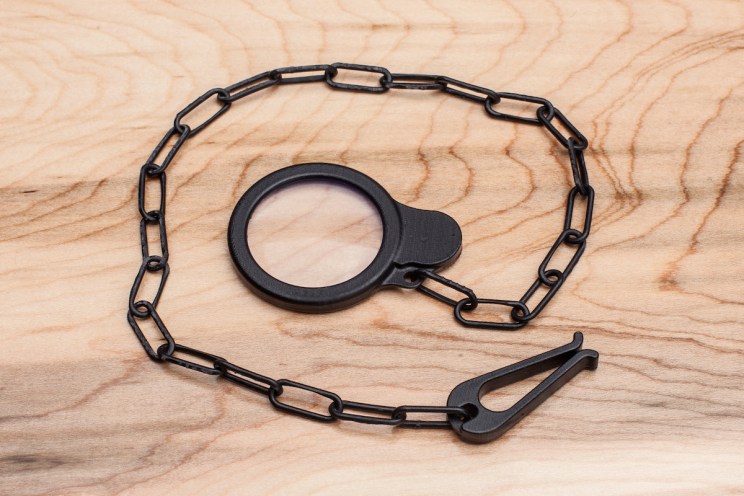Now this is some seriously cool stuff. The folks over at FormLabs decided to try a little experiment to test the optical clarity of their clear resin. It’s pretty damn clear.
Using their own slicing software, PreForm, [Craig Broady] printed the lens piece in an orientation that would maximize resin flow around the lens to help prevent defects, keeping it as smooth as possible. While the printed part looks quite clear, all lenses require some form of polishing to become optically clear. It was printed with a 50 micron resolution, and [Craig] used a power drill to sand the lens down from 220 grit to 2000 grit sand paper.
Once it was pretty smooth he switched over to polishing compound, using a piece of cork board to spin the lens against. He used Novus scratch remover to do this. Once it was clear to his liking, he repeated the whole process on the other side. He then popped it into his 3D printed monocle and chain and boom — an entirely 3D printed monocle.
SLA printers are expensive, but imagine the possibilities — make your own glasses!
[Thanks Jennifer!]

















Getting glasses in third world countries is still very difficult and pricey.
these guys cound make a change there !!
The required polishing process means that this technique is just as costly and just as difficult as milling lenses from blanks on a lathe, as is commonly done for contact lenses.
Where this process wins is in the ability to produce aspheric lenses that are difficult or impossible to produce using existing mechanisms.
For instance if these guys were to team up with the people making the oculus rift clone, they could make some really nice custom lenses for it and maybe even make it usable.
You are probably more specifically meaning astigmatic lenses or lenses with cylindrical components. Eyeglasses typically use simple lenses for which aspherics aren’t a useful item. I guess astigmatic lenses are also aspheric, but in most conversations the term aspheric is related to axially symmetric lenses that compensate for dispersion errors for color correction purposes.
With an aspheric lens it isn’t possible to correct dispersion errrors (chromatic aberration) because the source for chromatic aberrations ist the change of the index of refraction with wavelength (or better frequency).
https://www.ted.com/talks/josh_silver_demos_adjustable_liquid_filled_eyeglasses
do u know the cost of the clear resin?
Maybe not for the glasses on your nose, but could make a whole range of prototypes/tests/experiments with optics possible. You could probably do some cool lighting fixtures where the imperfections doesn’t matter that much.
This idea should work not just for lenses, but prisms, mirrors and any other optical device you can think of (printed fresnel lenses and optical light guides for example).
Fresnel lenses are what I thought of immediately as well.
3D printed Fresnel lenses is what everyone keeps saying.. but the sanding process would absolutely destroy the sharp angled peaks.. and any gap-filling technique would fill in the valleys. I just don’t see it happening. Fresnels are best made via injection molding from what I can guess.
Fresnel: http://www.teara.govt.nz/files/di-6675-enz.jpg
You might be able to get away with one that transmits 50-70% of the light but it won’t be optically clear, could be useful for just harnessing the power of the sun.
I agree. Also, if you want to have a computer make your Fresnel (or a mold for casting them), you’re probably better off with a CNC lathe.
It’s not the peaks that are most important. Its the curved surface between the peaks that focus the light. The problem for this technique is that the surface left by the deposition process is rough and needs polishing and there isn’t a good way to do that on a fresnel lens. In big glass lenses they made large individual rings which could be polished and then assembled for light house use, saving a large mass and large transmission losses (much glass wasn’t optical glass back then, so making it thicker made it green colored.) http://en.wikipedia.org/wiki/Fresnel_lens
Well defined peaks are important if you want to see a clear image through a compact fresnel lens.
If on the other hand you are building a light house then my apologies.. :p
ehm, no? Three_d_dave is correct. You want each circular segment to project a clear image in the same spot. To make it do that, the whole surface should be curved right, not just the surface of the ‘peak’.
Uh, well, it’s nice of course. But as much as I want it to happen, I really don’t see 3D printed ophtalmic lenses in the short or medium term. I’m going out on a limb and say that they probably will never be 3D printed as long as it implies using a nozzle moving around. Wearing glasses myself, I just can’t see how it can get anywhere near the level of precision of even cheaply manufactured ones, and coatings really make or break lenses that are in everyday use. Combine that with the fact that even high-quality ophtalmic lenses are ridiculously cheap to produce.
Now what I can _really_ get behind, though, is custom printed _frames_. That monocle looks pretty decent.
And of course, this is awesome for anything that needs to be clear and isn’t an optical lens.
“3d printing” in general does not imply FDM, and Formlabs in particular sells SLAs. So when you say “as long as it implies using a nozzle moving around”, you’re saying your comment doesn’t apply to this article.
That said, I agree that there’s a very long way from this to practical corrective lenses. At this stage, lighting optics are a much more obvious application.
SLA printers do not have a nozzle that moves around. It’s UV curing resin getting shot at by a UV projector.
Hi, as people said you can use as fresnel ( because les job in clear them)in front of solar panel increasing the efficence with cheap lenses.
Does this mean we’re getting closer to printing optical computers yet?
No.
we’ve been testing optical clear resin and it really works.. we had to put a layer of clear nail polish to get it really working.. but no polishing was really needed ,, checkout this print..
https://image-store.slidesharecdn.com/ea7bcf12-7783-44cb-a771-204613487a9d-original.jpeg
sla and water clear resin is really a posibility
Yep, any compound with a similar refractive index would work just as well as polishing.
It’s against the law to make a concave lens to 3 figure diopter accuracy. The glasses industry protects it’s market.
Umm… source/citation please?
You could not read it it, it’s all in a north korean dialect I bet.
There is a fairly large market for plastic camera lenses. Diana and Lensbaby have made a nitch for themselves. If someone could make some cheap plastic versions of ultra expensive lenses like ultrawides and giant telephotos A lot of photographers whould buy them to play around with!
It would, but those lenses require the use of multiple materials in order to prevent chromatic dispersion. AKA prismatic dispersion, the effect produces colored smears in otherwise sharp images as different colors are focused to different depths and are sent to different locations in spite of originating at the same real point.
There needs to be a pretty large difference in refractive index to get that to work and I don’t think polymers have that range. The do use injection molded plastic elements in some of those expensive lenses, but there are a lot of pieces of real glass that go along with them.
3D printed crappy lenses, at high prices, for Lomography. Amazing how much people will spend to get just the right degree and type of badness in their photos.
There are reproductions of a Petzval lens, made with modern camera mountings. The Petzval is so bad it has a rather soft focus all over with a built in blurriness around the edge. In short, the design was a really crappy lens with a slew of defects that lens designers labored for decades to eradicate.
Now people will spend $600 for a horrible lens just to take a certain type of bad photo. I guess that’s “art” putting a knee to the groin of two hundred years of painstaking R&D toward lenses that take precise and perfect photos.
Exactly. Make a Petzval lens out of all plastic, with removable aperature disks that are shaped like stars and hearts. If it could be sold for $99 or less, it would be a success, and lots of fun to shoot.
Unfortunately you are a bit too optimistic about the expensive lenses, even DSLR’s frequently come with poor lenses that have fringing and it’s fixed in the camera’s firmware. And I’ve seen expensive lenses that give some rather unsharp results.
I think we might need another 200 years
This actually gives me an idea. Print a parabolic telescope mirror. Polish or fill in the gaps and coat with aluminum (this will probably be the hardest part). Don’t even need to be clear and can probably be done even with extrusion printers.
This could be really useful for Herschelian design.
Of course with Herschelian design the idea would be to print not a parabolic but kind of skewed parabolic mirror, to compensate for aberrations.
Objects with parabolic shapes are around all over the place, but making them optically reflective is the hard part.
Even the bottom of your can of shaving gel probably would make a nice reflector lens.
In fact making parabolic shapes is probably much better done by taking a flat surface and heating it then bending it rather than messing with 3D printing.
that, and maybe using a larger print resolution to deliberately produce lines, like a Fresnel lens?
another way to polish a curved lens is to print the opposite profile onto a disc. mount the lens to be polished in a holder and line the concave surface with felt. using a liquid polishing slurry, spin the lens holder and let the concave part freely rotate. It works best if you can oscillate it back and forth 30-45 degrees. This gives you a lot of control over the finished profile of the lens, and allows a much thicker lens with more curve. Since you’ve got the model for the lens, you can be guaranteed to print the exact matching inverse profile for keeping your lens in tolerance.